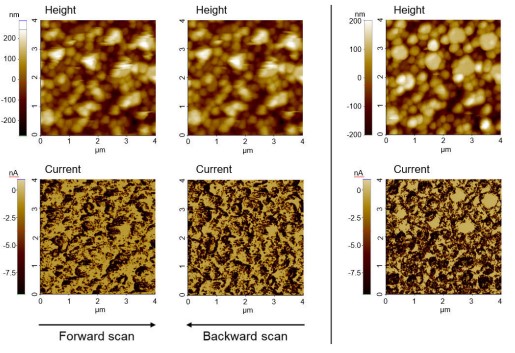PinPoint™ 导电AFM在电流测量中获得了高分辨率和灵敏度
PinPoint™ 导电AFM旨在实现探针与样品之间良好定义的电接触。在测量电流时,XY扫描仪会停止运动,接触时间由用户控制。PinPoint™导电AFM具有更高的空间分辨率,无侧向力,可在不同样品表面上进行优化的电流测量。

PinPoint™ 导电AFM是为了在探针和样品之间建立明确的电接触而开发的。在测量电流时,XY扫描器停止,接触时间由用户控制。PinPoint™ 导电AFM允许更高的空间分辨率,没有侧向力,并在不同的样品表面上优化电流测量。
PinPoint™ 导电AFM旨在实现探针与样品之间良好定义的电接触。在测量电流时,XY扫描仪会停止运动,接触时间由用户控制。PinPoint™导电AFM具有更高的空间分辨率,无侧向力,可在不同样品表面上进行优化的电流测量。

在过去的30年里,原子力显微镜(AFM)已被广泛用于纳米尺度上研究材料和现象。特别是,AFM能够同时测量像导电性或压电效应这样的功能性电学性质以及形貌,使AFM成为半导体、传感器或能源应用(如太阳能电池)等许多领域的重要分析工具。然而,在标准接触模式中,探针磨损和对表面的损伤仍然是限制可重复性和悬臂寿命的主要挑战之一。
为了克服这些问题,Park Systems开发了PinPoint纳米电学模式,该模式消除了悬臂探针和表面之间的侧向剪切力,从而在确保高成像质量和可重复性的同时,大大减少了对广泛样品的损伤,即使在多次连续测量中也是如此。在PinPoint模式下,每个像素都会测量一个力-距离曲线,允许探针和表面之间建立明确且安全的物理接触。XY和Z扫描器的解耦使得在力-距离曲线测量期间,探针能够精准地接近和远离样品表面,而不会在X或Y方向上产生侧向移动,从而有效地消除了探针磨损。因此,这种模式特别适用于表征对剪切力敏感的样品,如软聚合物、生物样品或弱吸附分子。PinPoint可以与其他AFM模式结合使用,以获取有关以下电学性质的信息:
此外,在PinPoint测量过程中,每个数据点都会同时收集高速的力-距离曲线。因此,该模式能够同时实现样品的电学特性表征,以及它们的表面形貌和机械性质的测量(更多详情请参阅“PinPoint纳米机械模式说明”)。

图1. (a) F14H20的高度图像(非接触模式) (b) F14H20的高度图像(轻敲模式) (c) 线形轮廓比较
导电原子力显微镜(C-AFM)是一种常用的技术,用于表征各种样品类型(如绝缘体、半导体和导体)的电流分布(例如,局部电导)。在C-AFM中,在扫描过程中向样品施加偏压电压,并通过探针测量电流流动。然而,电流不仅取决于样品的局部特性,还受到接触力和探针几何形状的影响。因此,由于磨损导致的探针几何形状的变化可能会改变测得的电流,从而降低测量的可重复性和准确性。
相比之下,PinPoint C-AFM通过精准控制接触力和数据采集时间,可以在AFM探针和样品之间提供明确定义的电学接触。此外,通过消除侧向剪切力,PinPoint C-AFM能够实现具有高空间分辨率和高可重复性的成像。
图1展示了在垂直生长的氧化锌纳米棒样品上进行的传统C-AFM(导电原子力显微镜)与PinPoint C-AFM测量的对比。传统C-AFM由于侧向力对探针和样品的损伤,导致成像质量较差,从而在高度和电流图像中降低了空间分辨率并产生了成像伪影。相比之下,PinPoint C-AFM模式产生了如图1(b)所示的无伪影的锐利高度和电流图像。

在图2中,我们看到了通过传统的基于接触的相位调制显微镜(PFM)(a)和PinPoint PFM(b)获得的经退火的菲南烯薄膜的AFM高度和PFM四象限图像。在(a)中,菲南烯在接触扫描期间受到侧向力的影响而移动。而使用PinPoint模式时,可以避免这个问题,如(b)所示。
压电力显微镜(PFM)允许通过探针施加偏压电压来测量压电和铁电材料的电机械响应。样品中的局部压电畴在探针和样品之间的电场作用下扩张或收缩,这种变化通过悬臂的机械位移来检测。然而,这种位移响应有时相对较小,导致使用传统PFM测量时信噪比小且难以检测。由于PinPoint PFM允许精准控制探针-样品交互的接触力和接触持续时间,因此可以轻松地优化测量参数,以实现高空间分辨率的电机械性质映射。图2展示了在ITO表面上的退火菲南烯薄膜上进行的传统PFM和PinPoint PFM测量的对比。样品表面的棒状纳米结构在接触扫描过程中容易发生位移,导致AFM图像中出现伪影,如图2(a)所示。相比之下,PinPoint PFM显示了改进的高度和PFM信号(图2(b))。
扫描扩展电阻显微镜(SSRM)是研究半导体电流和电阻分布的一种定量工具。通常,这些材料表面覆盖着薄层的表面污染或表面氧化物层,这些层会阻碍电荷传输,从而阻碍电阻分布测量。为了解决这个问题,用于SSRM测量的典型AFM探针通常涂有硬材料,如薄金刚石膜,以刮除氧化物/污染层,从而建立良好的电接触。 由于需要高恒定力来切割坚硬的绝缘氧化物层,探针磨损和导电涂层层中的表面缺陷是与该测量模式相关的典型问题,导致横向分辨率降低和电接触不稳定。使用PinPoint模式可以大大解决这些问题。因此,PinPoint SSRM提供了准确且可重复的数据,如图3所示。

图3展示了使用PinPoint SSRM模式在锂离子电池电极上同时获得的(a)AFM高度、(b)电阻和(c)刚度图像。这三个通道在一次扫描中同时获取。样品偏压设置为+3 V。测量在真空中的NX-Hivac系统中进行。